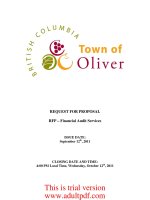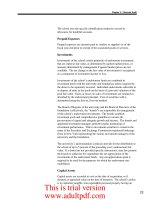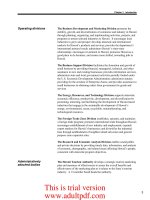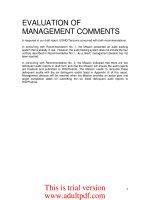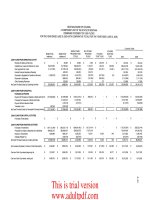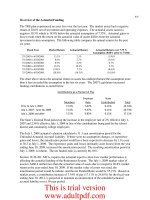Financial Audit Manual_part2 potx
Bạn đang xem bản rút gọn của tài liệu. Xem và tải ngay bản đầy đủ của tài liệu tại đây (62.54 KB, 12 trang )
100 – INTRODUCTION
July 2001 GAO/PCIE Financial Audit Manual Page 100-3
provisions of laws and regulations; and relevant controls over the entity's
operations;
determining the likelihood of effective information systems (IS) controls;
performing a preliminary risk assessment to identify high-risk areas,
including considering the risk of fraud; and
planning entity field locations to visit.
Internal Control Phase
.04 This phase entails evaluating and testing internal control to support the
auditor's conclusions about the achievement of the following internal control
objectives:
Reliability of financial reporting—transactions are properly recorded,
processed, and summarized to permit the preparation of the principal
statements and required supplementary stewardship information (RSSI)
in accordance with generally accepted accounting principles (GAAP), and
assets are safeguarded against loss from unauthorized acquisition, use,
or disposition.
Compliance with applicable laws and regulations—transactions are
executed in accordance with (a) laws governing the use of budget
authority and other laws and regulations that could have a direct and
material effect on the principal statements or RSSI and (b) any other
laws, regulations, and governmentwide policies identified by OMB in its
audit guidance.
OMB audit guidance requires the auditor to test controls that have been
properly designed to achieve these objectives and placed in operation, to
support a low assessed level of control risk. This may be enough testing to
give an opinion on internal control. GAO audits should be designed to give
This is trial version
www.adultpdf.com
100 – INTRODUCTION
July 2001 GAO/PCIE Financial Audit Manual Page 100-4
an opinion on internal control.
4
If the auditor does not give an opinion,
generally accepted government auditing standards (GAGAS) require the
report to state whether tests were sufficient to give an opinion.
.05 OMB’s audit guidance includes a third objective of internal control, related to
performance measures. The auditor is required to understand the
components of internal control relating to the existence and completeness
assertions and to report on internal controls that have not been properly
designed and placed in operation, rather than to test controls.
.06 This manual also provides guidance on evaluating internal controls related to
operating objectives that the auditor elects to evaluate. Such controls include
those related to safeguarding assets from waste or preparing statistical
reports.
.07 To evaluate internal control, the auditor identifies and understands the
relevant controls and tests their effectiveness. Where controls are considered
to be effective, the extent of substantive testing can be reduced.
.08 The methodology includes guidance on
assessing specific levels of control risk,
selecting controls to test,
determining the effectiveness of IS controls, and
testing controls, including coordinating control tests with the testing
phase.
.09 Also, during the internal control phase, for CFO Act agencies and their
components identified in OMB’s audit guidance, the auditor should
understand the entity’s significant financial management systems and test
their compliance with FFMIA requirements.
4
AICPA attestation standards allow the auditor to give an opinion on internal
control or on management’s assertion about the effectiveness of internal
control (except that if material weaknesses are present, the opinion must be
on internal control, not management’s assertion). The example report in this
manual assumes the opinion will be on internal control directly.
This is trial version
www.adultpdf.com
100 – INTRODUCTION
July 2001 GAO/PCIE Financial Audit Manual Page 100-5
Testing Phase
.10 The objectives of this phase are to (1) obtain reasonable assurance about
whether the financial statements are free from material misstatements,
(2) determine whether the entity complied with significant provisions of
applicable laws and regulations, and (3) assess the effectiveness of internal
control through control tests that are coordinated with other tests.
.11 To achieve these objectives, the methodology includes guidance on
designing and performing substantive, compliance, and control tests;
designing and evaluating audit samples;
correlating risk and materiality with the nature, timing, and extent of
substantive tests; and
designing multipurpose tests that use a common sample to test several
different controls and specific accounts or transactions.
Reporting Phase
.12 This phase completes the audit by reporting useful information about the
entity, based on the results of audit procedures performed in the preceding
phases. This involves developing the auditor's report on the entity's
(1) financial statements (also called Principal Statements) and other
information (management’s discussion and analysis [MD&A] or the overview,
RSSI, other required supplementary information, and other accompanying
information), (2) internal control, (3) whether the financial management
systems substantially comply with FFMIA requirements, and (4) compliance
with laws and regulations. To assist in this process, the methodology
includes guidance on forming opinions on the principal statements and
conclusions on internal control, as well as how to determine which findings
should be reported. Also included is an example report designed to be
understandable to the reader.
This is trial version
www.adultpdf.com
100 – INTRODUCTION
July 2001 GAO/PCIE Financial Audit Manual Page 100-6
RELATIONSHIP TO APPLICABLE STANDARDS
.13 The following section describes the relationship of this audit methodology to
applicable auditing standards, OMB guidance, and other policy
requirements. It is organized into three areas:
relevant auditing standards and OMB guidance,
audit requirements beyond the “yellow book,” and
auditing standards and other policies not addressed in this manual.
Relevant Auditing Standards and OMB Guidance
.14 This manual provides a framework for performing financial statement audits
in accordance with Government Auditing Standards (also known as generally
accepted government auditing standards or GAGAS) issued by the
Comptroller General of the United States ("yellow book"); incorporated
generally accepted auditing standards (GAAS) and attestation standards
established by the American Institute of Certified Public Accountants
(AICPA); and OMB’s audit guidance.
.15 This manual describes an audit methodology that both integrates the
requirements of the standards and provides implementation guidance. The
methodology is designed to achieve
effective audits by considering compliance with the CFO Act, FFMIA,
GAGAS, and OMB guidance;
efficient audits by focusing audit procedures on areas of higher risk and
materiality and by providing an integrated approach designed to gather
evidence efficiently;
quality control through an agreed-upon framework that can be followed
by all personnel; and
consistency of application through a documented methodology.
.16 The manual supplements GAGAS and OMB’s audit guidance. References are
made to Statements on Auditing Standards (preceded by the prefix "AU") and
Statements on Standards for Attestation Engagements (SSAE) (preceded by
This is trial version
www.adultpdf.com
100 – INTRODUCTION
July 2001 GAO/PCIE Financial Audit Manual Page 100-7
the prefix "AT") of the Codification of Statements on Auditing Standards,
issued by the AICPA, that are incorporated into GAGAS.
Audit Requirements Beyond the “Yellow Book”
.17 In addition to meeting GAGAS requirements, audits of federal entities to
which OMB's audit guidance applies must be designed to achieve the
following objectives described in OMB’s audit guidance:
responsibility for performing sufficient tests of internal controls that
have been properly designed and placed in operation, to support a low
assessed level of control risk;
expansion of the nature of controls that are evaluated and tested to
include controls related to RSSI, budget execution, and compliance with
laws and regulations;
responsibility to understand the components of internal control relating
to the existence and completeness assertions relevant to the performance
measures included in the MD&A, in order to report on controls that have
not been properly designed and placed in operation;
responsibility to consider the entity's process for complying with 31
U.S.C. 3512 (the Federal Managers' Financial Integrity Act (FMFIA));
responsibility to perform tests at CFO Act agencies and components
identified by OMB to report on the entity's financial management
systems' substantial compliance with FFMIA requirements;
responsibility to test for compliance with laws, regulations, and
governmentwide policies identified in OMB’s audit guidance at CFO Act
agencies (regardless of their materiality to the audit); and
responsibility to consider conformity of the MD&A, RSSI, required
supplementary information, and other accompanying information with
FASAB requirements and OMB guidance.
This is trial version
www.adultpdf.com
100 – INTRODUCTION
July 2001 GAO/PCIE Financial Audit Manual Page 100-8
.18 To help achieve the goals of the CFO Act, GAO audits should be designed to
achieve the following objectives,
5
in addition to those described in OMB’s
audit guidance:
Provide an opinion on internal control.
Determine the effects of misstatements and internal control weaknesses
on (1) the achievement of operations control objectives, (2) the accuracy of
reports prepared by the entity, and (3) the formulation of the budget.
Determine whether specific control activities are properly designed and
placed in operation, even if a poor control environment precludes their
effectiveness.
Understand the components of internal control relating to the valuation
assertion relevant to performance measures reported in the MD&A in
order to report on controls that have not been properly designed and
placed in operation.
Auditing Standards and Other Policies Not Addressed in the Manual
.19 This manual was designed to supplement financial audit and other policies
and procedures adopted by GAO and Inspectors General (IGs). As such, it
was not intended to address in detail all requirements. For example, report
processing is not addressed.
.20 Updates to this manual that include additional audit guidance and practice
aids, such as checklists and audit programs, will be issued from time to time.
GAO and a team representing the PCIE audit committee will be responsible
for preparing the updates. There will be an exposure process for significant
updates.
KEY IMPLEMENTATION ISSUES
.21 The auditor should consider the following factors in applying the
methodology to a particular entity:
5
The manual refers specifically to objectives of GAO audits in various
sections. Such objectives are optional for other audit organizations.
This is trial version
www.adultpdf.com
100 – INTRODUCTION
July 2001 GAO/PCIE Financial Audit Manual Page 100-9
audit objectives,
exercise of professional judgment,
references to positions,
use of IS auditors,
compliance with policies and procedures in the manual,
use of technical terms, and
reference to GAO/PCIE Financial Audit Manual (FAM).
Audit Objectives
.22 While certain federal entities are not subject to OMB audit guidance,
financial statement audits of all federal entities should be conducted in
accordance with this guidance to the extent applicable to achieve the audit's
objectives. The manual generally assumes that the objective of the audit is to
render an opinion on the current year financial statements, a report on
internal control, and a report on compliance. Where these are not the
objectives, the auditor should use judgment in applying the guidance. In
some circumstances, the auditor will expect to issue a disclaimer on the
current year financial statements (because of scope limitations). In these
circumstances, the auditor may develop a multiyear plan to be able to render
an opinion when the financial statements are expected to become auditable.
Exercise of Professional Judgment
.23 In performing a financial statement audit, the auditor should exercise
professional judgment. Consequently, the auditor should tailor the guidance
in the manual to respond to situations encountered in an audit. However,
the auditor must exercise judgment properly, assuring that, at a minimum,
the work meets professional standards. Proper application of professional
judgment could result in additional or more extensive audit procedures than
described in this manual.
.24 In addition, when exercising judgment, the auditor should consider the needs
of, and consult in a timely manner with, other auditors who plan to use the
work being performed. In turn, the auditor should coordinate with other
auditors whose work he or she wishes to use so that the judgments exercised
can satisfy the needs of both auditors. For example, auditors of a
consolidated entity (such as the US Government or an entire department or
agency) are likely to plan to use the work of auditors of subsidiary entities
This is trial version
www.adultpdf.com
100 – INTRODUCTION
July 2001 GAO/PCIE Financial Audit Manual Page 100-10
(such as individual departments and agencies or bureaus and components of
a department). This coordination can result in more economy, efficiency, and
effectiveness of government audits in general and avoid duplication of effort.
.25 Many aspects of the audit require technical judgments. The auditor should
ensure a person(s) with adequate technical expertise is (are) available,
especially in the following areas:
quantifying planning materiality, design materiality, and test
materiality and using materiality as one consideration in determining
the extent of testing (see section 230);
specifying a minimum level of substantive assurance based on the
assessed combined risk, analytical procedures, and detail tests (see
sections 470, 480, and 495 D);
documenting whether selections are samples (intended to be
representative and projected to populations) or nonsampling selections
that are not projectible (see section 480);
using sampling methods, such as dollar-unit sampling, classical variables
estimation sampling, or classical probability proportional to size (PPS)
sampling, for substantive or multipurpose testing (including
nonstatistical sampling) (see section 480);
using sampling for control testing, other than attribute sampling using
the tables in section 450 to determine sample size when not performing a
multipurpose test;
using sampling for compliance testing of laws and regulations, other than
attribute sampling using the tables in section 460 to determine sample
size when not performing a multipurpose test; and
placing complete or partial reliance on analytical procedures, using test
materiality to calculate the limit. The limit is the amount of difference
between the expected and recorded amounts that can be accepted without
further investigation (see section 475).
This is trial version
www.adultpdf.com
100 – INTRODUCTION
July 2001 GAO/PCIE Financial Audit Manual Page 100-11
References to Positions
.26 Various sections of this manual make reference to consultation with audit
management and/or persons with technical expertise to obtain approval or
additional guidance. Key consultations should be documented in the audit
workpapers. Each audit organization should document, in the workpapers or
its audit policy manual, the specific positions of persons who will perform
these functions. An IG using a firm to perform an audit in accordance with
this manual should clarify and document the positions of the persons the firm
should consult in various circumstances.
• The Assistant Director is the top person responsible for the day-to-day
conduct of the audit.
The Audit Director is the senior manager responsible for the technical
quality of the financial statement audit, reporting to the Assistant
Inspector General for Audit or, at GAO, to the Managing Director.
The Reviewer is the senior manager responsible for the quality of the
auditor's reports, reporting to the Assistant Inspector General for Audit
(or higher position) or, at GAO, is the Managing Director or the second
partner. The Reviewer may consult with others.
• The Statistician is the person the auditor consults for technical
expertise in areas such as audit sampling, audit sample evaluation, and
selecting entity field locations to visit.
• The Data Extraction Specialist is the person with technical expertise
in extracting data from agency records.
The Technical Accounting and Auditing Expert is the senior
manager reporting to the Assistant Inspector General for Audit or higher
or, at GAO, is the Chief Accountant. The Technical Accounting and
Auditing Expert advises on accounting and auditing professional matters
and related national issues. The Technical Accounting and Auditing
Expert reviews reports on financial statements and reports that contain
opinions on financial information.
The Office of General Counsel (OGC) provides assistance to the
auditor in (1) identifying provisions of laws and regulations to test,
This is trial version
www.adultpdf.com
100 – INTRODUCTION
July 2001 GAO/PCIE Financial Audit Manual Page 100-12
(2) identifying budget restrictions, and (3) identifying and resolving legal
issues encountered in the financial statement audit, such as evaluating
potential instances of noncompliance.
The Special Investigator Unit investigates specific allegations
involving conflict-of-interest and ethics matters, contract and
procurement irregularities, official misconduct and abuse, and fraud in
federal programs or activities. In the offices of the IGs this is the
investigation unit; at GAO, it is Special Investigations. The Special
Investigator Unit provides assistance to the auditor by (1) informing the
auditor of relevant pending or completed investigations of the entity and
(2) investigating possible instances of federal fraud, waste, and abuse.
Use of Information Systems Auditors
.27 The audit standards (SAS 94) require that the audit team possess sufficient
knowledge of information systems (IS) to determine the effect of IS on the
audit, to understand the IS controls, and to design and perform tests of IS
controls and substantive tests. This is generally done by having IS auditors
as part of the audit team. IS auditors should possess sufficient technical
knowledge and experience to understand the relevant concepts discussed in
the manual and to apply them to the audit. While the auditor is ultimately
responsible for assessing inherent and control risk, assessing the
effectiveness of IS controls requires a person with IS audit technical skills.
Specialized technical skills generally are needed in situations where, (1) the
entity’s systems, automated controls, or the manner in which they are used
in conducting the entity’s business are complex, (2) significant changes have
been made to existing systems or new systems implemented, (3) data are
extensively shared among systems, (4) the entity participates in electronic
commerce, (5) the entity uses emerging technologies, or (6) significant audit
evidence is available only in electronic form. Appendix V of GAO’s Federal
Information System Controls Audit Manual (FISCAM) contains examples of
knowledge, skills, and abilities needed by IS auditors. Certain financial
auditors also may possess IS audit technical skills. In some cases, the
auditor may require outside consultants to provide these skills.
Compliance With Policies and Procedures in the Manual
.28 The following terms are used throughout the manual to describe the degree of
compliance with the policy or procedure required.
This is trial version
www.adultpdf.com
100 – INTRODUCTION
July 2001 GAO/PCIE Financial Audit Manual Page 100-13
Must: Compliance with this policy or procedure is mandatory
unless an exception is approved in writing by the Reviewer,
6
such as in certain instances when a disclaimer of opinion is
anticipated.
Should: Compliance with this policy or procedure is expected unless
there is a reasonable basis for departure from it. Any such
departure and the basis for it are to be documented in a
memorandum. The Assistant Director should approve this
memorandum and copies should be sent to the Audit
Director and the Reviewer.
Generally
Should: Compliance with this policy or procedure is strongly
encouraged. Departure from such policy or procedure
should be discussed with the Assistant Director or the audit
manager.
May: Compliance with this policy or procedure is optional.
When the auditor deviates from a policy or procedure that is expressed by
use of the term "must" or "should" in the FAM, he or she should consider the
needs of, and consult in a timely manner with, other auditors who plan to
use the work of the auditor and provide an opportunity for the other auditors
to review the documentation explaining these deviation decisions.
Use of Technical Terms
.29 The manual uses many existing technical auditing terms and introduces
many others. To assist you, a glossary of significant terms is included in this
manual.
6
Capitalized positions are described in paragraph 100.25.
This is trial version
www.adultpdf.com
100 – INTRODUCTION
July 2001 GAO/PCIE Financial Audit Manual Page 100-14
Reference to GAO/PCIE Financial Audit Manual
.30 When cited in workpapers, correspondence, or other communication, the
letters “FAM” should precede section or paragraph numbers from this
manual. For example, this paragraph should be referred to as FAM 100.30.
This is trial version
www.adultpdf.com
